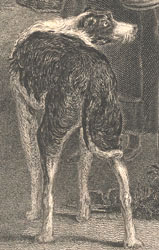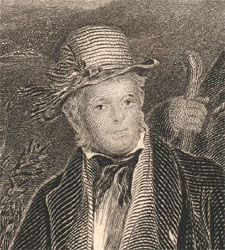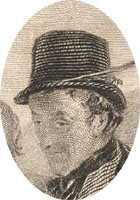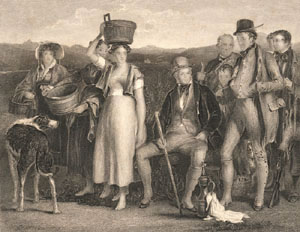|
|
Home | Corson
Collection | Biography | Works | Image
Collection | Recent
Publications | Correspondence | Forthcoming
Events | Links | E-texts | Contact
The Abbotsford Family (1817)
Sir David Wilkie first met
Scott in London in 1809 when both dined with the publisher John
Murray. He found the writer 'most interesting in conversation'
and 'very communicative of the all but universal knowledge he has
acquired'. Their paths did not however cross again until October
1817 when Wilkie was invited to Abbotsford during
a visit to Scotland. Here he was commissioned by Scott's friend
Sir Adam Fergusson to paint the group composition that was to become The
Abbotsford Family. He began work immediately, making rapid
progress on the picture during the fortnight that he spent as a
guest of Scott. The portraits of Lady Scott, Scott's daughters
Sophia and Anne, son's Walter and Charles, friend Sir Adam Fergusson,
and shepherd Thomas Scott are all taken from life. Scott himself
provided Wilkie with a dilemma. He was loath to trouble Scott to
sit for a portrait as he knew him to be hard at work on Rob
Roy.
After several days, however, he perceived that Scott 'always had
time
for less important purposes' and conquered his scruples. The painting
was displayed in the 1818 exhibition at the Royal Academy, but
there is evidence that the artist worked upon it subsequently,
retouching
in particular the portrait of Lady Scott which her husband did
not judge to be a good likeness.
|
|
Click on the thumbnail
to see a full-size engraving of The Abbotsford
Family by John Smith
|
|
Scott later described the painting in a letter to Fergusson of
7 March 1827:
 The
idea which our inimitable Wilkie adopted was to represent
our family group in the garb of South country peasants supposed
to be concerting a merry-making, for which some of the preparations
are seen. The place is the terrace near Kayside [or
'Kaeside', a property added to the Abbotsford estate in 1817],
commanding an extensive view towards the Eildon Hills. 1.
The sitting figure, in the dress of a miller, I believe,
represents Sir Walter Scott author of a few scores of volumes,
and proprietor of Abbotsford. 2. In front, and presenting,
we may suppose, a country wag, addicted to poaching stands
Sir Adam Fergusson, Knight-Keeper of the Regalia of Scotland.
3. In the background is a very handsome old man [Thomas
Scott], upwards of eighty four
years old at the time, painted in his own character of a
shepherd. He used to claim credit for three things unusual
among the South-land shepherds: first, that he had never
been fou [drunk] in
the course of his life; secondly, never had struck a man
in anger; thirdly, that though entrusted with the management
of large sales of stock, he had never lost a penny for his
master by a bad debt. He died soon afterwards, at Abbotsford.
4. 5. 6. Of the three female figures the eldest is the late
regretted mother of the family represented. 5. The young
person most forward in the group is Miss Sophia Charlotte
Scott, now Mrs John Gibson Lockhart, and, 6, her younger
sister Miss Anne Scott. Both are represented as ewe milkers,
with their leglins, or milk pails. 7. On the left hand of
the shepherd, the young man holding a fowling-piece is the
eldest son of Sir Walter, now Captain in the Kings Hussars.
8. The boy is the youngest of the family, now, Charles Scott,
of Brazen Nose College, Oxford. The two dogs were distinguished
favourites of the family. The large one [Maida,
see right] was a stag-hound
of the old Highland breed, and one of the handsomest dogs
that could be found. He was a present from the Chief of Glengarry
to Sir Walter, and was highly valued both on account of his
beauty, his fidelity and the great rarity of the breed. The
other is a little Highland terrier called Ourisk (goblin),
of a particular kind bred in Kintail. It was a present from
the Honourable Mrs Stewart Mackenzie and is a valuable specimen
of a breed which is now also scarce. (Letters,
X, 168-69) The
idea which our inimitable Wilkie adopted was to represent
our family group in the garb of South country peasants supposed
to be concerting a merry-making, for which some of the preparations
are seen. The place is the terrace near Kayside [or
'Kaeside', a property added to the Abbotsford estate in 1817],
commanding an extensive view towards the Eildon Hills. 1.
The sitting figure, in the dress of a miller, I believe,
represents Sir Walter Scott author of a few scores of volumes,
and proprietor of Abbotsford. 2. In front, and presenting,
we may suppose, a country wag, addicted to poaching stands
Sir Adam Fergusson, Knight-Keeper of the Regalia of Scotland.
3. In the background is a very handsome old man [Thomas
Scott], upwards of eighty four
years old at the time, painted in his own character of a
shepherd. He used to claim credit for three things unusual
among the South-land shepherds: first, that he had never
been fou [drunk] in
the course of his life; secondly, never had struck a man
in anger; thirdly, that though entrusted with the management
of large sales of stock, he had never lost a penny for his
master by a bad debt. He died soon afterwards, at Abbotsford.
4. 5. 6. Of the three female figures the eldest is the late
regretted mother of the family represented. 5. The young
person most forward in the group is Miss Sophia Charlotte
Scott, now Mrs John Gibson Lockhart, and, 6, her younger
sister Miss Anne Scott. Both are represented as ewe milkers,
with their leglins, or milk pails. 7. On the left hand of
the shepherd, the young man holding a fowling-piece is the
eldest son of Sir Walter, now Captain in the Kings Hussars.
8. The boy is the youngest of the family, now, Charles Scott,
of Brazen Nose College, Oxford. The two dogs were distinguished
favourites of the family. The large one [Maida,
see right] was a stag-hound
of the old Highland breed, and one of the handsomest dogs
that could be found. He was a present from the Chief of Glengarry
to Sir Walter, and was highly valued both on account of his
beauty, his fidelity and the great rarity of the breed. The
other is a little Highland terrier called Ourisk (goblin),
of a particular kind bred in Kintail. It was a present from
the Honourable Mrs Stewart Mackenzie and is a valuable specimen
of a breed which is now also scarce. (Letters,
X, 168-69)
Scott himself (see detail below) is portrayed at full-length,
wearing a slate-blue coat, cerise waistcoat, white shirt, black
stock,
and
buff trousers
and hat, the costume which, according to a review in Blackwood's
Magazine was his customary attire when inspecting his estate.
The painting is 10¾ by 14½ inches.

The Scott family appear to have been highly pleased by the painting.
Scott wrote to Wilkie that 'I cannot tell you how acceptable the
picture has been to all who have seen and how much the relatives
of the party honoured (not always easily gratified you know) are
delighted with your having commemorated them' (letter of 23 January
1818, Letters, V, 93). Likewise, in a letter to Lady Compton,
he referred to is 'a very good picture' by 'this modest and most
promising artist' which is 'prodigiously admired by Scotch amateurs
at least as a piece of art'.
 Critical
reaction has been rather more mixed. For Blackwood's Magazine the
portrait might have lacked 'the fine poetical tone' of Sir Henry
Raeburn's 1808 portrait, but 'we
have seen no painting which places the individual, in his every-day feelings,
so completely before the spectator'. The Monthly Magazine,
conversely, condemned it as 'a most conceited design' which 'creates
pity for the painter and disgust at the objects, while it violates
decency and good taste'. Scott's son-in-law Lockhart regretted
that he could not 'express much approbation of the representation
of Sir Walter, introduced by Sir David Wilkie in his picture of "The
Abbotsford Family;'' nor indeed are any of the likenesses in that
beautiful piece (1817) at all satisfactory to me, except only that
of Sir Adam Fergusson [see detail right], which is perfect'
(Life, X, 263). A more recent biographer, Dame Una Pope-Hennessy
thought it 'a wax-like arrangement of expressionless little dummies'
to be dismissed as 'a kind of joke' (Quarterly Review,
259 (1932), 82). Critical
reaction has been rather more mixed. For Blackwood's Magazine the
portrait might have lacked 'the fine poetical tone' of Sir Henry
Raeburn's 1808 portrait, but 'we
have seen no painting which places the individual, in his every-day feelings,
so completely before the spectator'. The Monthly Magazine,
conversely, condemned it as 'a most conceited design' which 'creates
pity for the painter and disgust at the objects, while it violates
decency and good taste'. Scott's son-in-law Lockhart regretted
that he could not 'express much approbation of the representation
of Sir Walter, introduced by Sir David Wilkie in his picture of "The
Abbotsford Family;'' nor indeed are any of the likenesses in that
beautiful piece (1817) at all satisfactory to me, except only that
of Sir Adam Fergusson [see detail right], which is perfect'
(Life, X, 263). A more recent biographer, Dame Una Pope-Hennessy
thought it 'a wax-like arrangement of expressionless little dummies'
to be dismissed as 'a kind of joke' (Quarterly Review,
259 (1932), 82).
The Abbotsford Family remained in the Fergusson family
until 1895 when it was sold to the Scottish
National Portrait Gallery. It was engraved on four
occasions: by W.H. Worthington (1828),
Robert Graves (1837), John
Smith (1847), and
William Greatbach (184-?).
Click on the links below to see images of the engravings held by Edinburgh University
Library:
The full letter to Sir Adam Fergusson descriptive of the painting
was published in The Bijou, 1828, along with the engraving by W.H.
Worthington. Both may be viewed at the Romantic
Anthologies Web Site.
Bibliography
- Cunningham, Allan. The
Life of Sir David Wilkie: With His Journals, Tours, and Critical
Remarks on Works of Art; And a Selection from His Correspondence (London
: J. Murray, 1843)
- Johnson, Edgar. Sir
Walter Scott: The Great Unknown (London: Hamish Hamilton,
1970)
- Lockhart, John Gibson. Memoirs of
the Life of Sir Walter Scott, Bart., 2nd edn (Edinburgh:
R. Cadell, 1839)
- Mollett, John W. Sir David
Wilkie (London: Sampson Low, Marston, Searle, & Rivington,
1881)
- Russell, Francis. Portraits
of Sir Walter Scott: A Study of Romantic Portraiture (London:
The Author, 1987)
Back to Index

Last updated: 3-June-2005
© Edinburgh University Library
|
|


 The
idea which our inimitable Wilkie adopted was to represent
our family group in the garb of South country peasants supposed
to be concerting a merry-making, for which some of the preparations
are seen. The place is the terrace near Kayside [or
'Kaeside', a property added to the Abbotsford estate in 1817],
commanding an extensive view towards the Eildon Hills. 1.
The sitting figure, in the dress of a miller, I believe,
represents Sir Walter Scott author of a few scores of volumes,
and proprietor of Abbotsford. 2. In front, and presenting,
we may suppose, a country wag, addicted to poaching stands
Sir Adam Fergusson, Knight-Keeper of the Regalia of Scotland.
3. In the background is a very handsome old man [Thomas
Scott], upwards of eighty four
years old at the time, painted in his own character of a
shepherd. He used to claim credit for three things unusual
among the South-land shepherds: first, that he had never
been fou [drunk] in
the course of his life; secondly, never had struck a man
in anger; thirdly, that though entrusted with the management
of large sales of stock, he had never lost a penny for his
master by a bad debt. He died soon afterwards, at Abbotsford.
4. 5. 6. Of the three female figures the eldest is the late
regretted mother of the family represented. 5. The young
person most forward in the group is Miss Sophia Charlotte
Scott, now Mrs John Gibson Lockhart, and, 6, her younger
sister Miss Anne Scott. Both are represented as ewe milkers,
with their leglins, or milk pails. 7. On the left hand of
the shepherd, the young man holding a fowling-piece is the
eldest son of Sir Walter, now Captain in the Kings Hussars.
8. The boy is the youngest of the family, now, Charles Scott,
of Brazen Nose College, Oxford. The two dogs were distinguished
favourites of the family. The large one [Maida,
see right] was a stag-hound
of the old Highland breed, and one of the handsomest dogs
that could be found. He was a present from the Chief of Glengarry
to Sir Walter, and was highly valued both on account of his
beauty, his fidelity and the great rarity of the breed. The
other is a little Highland terrier called Ourisk (goblin),
of a particular kind bred in Kintail. It was a present from
the Honourable Mrs Stewart Mackenzie and is a valuable specimen
of a breed which is now also scarce. (Letters,
X, 168-69)
The
idea which our inimitable Wilkie adopted was to represent
our family group in the garb of South country peasants supposed
to be concerting a merry-making, for which some of the preparations
are seen. The place is the terrace near Kayside [or
'Kaeside', a property added to the Abbotsford estate in 1817],
commanding an extensive view towards the Eildon Hills. 1.
The sitting figure, in the dress of a miller, I believe,
represents Sir Walter Scott author of a few scores of volumes,
and proprietor of Abbotsford. 2. In front, and presenting,
we may suppose, a country wag, addicted to poaching stands
Sir Adam Fergusson, Knight-Keeper of the Regalia of Scotland.
3. In the background is a very handsome old man [Thomas
Scott], upwards of eighty four
years old at the time, painted in his own character of a
shepherd. He used to claim credit for three things unusual
among the South-land shepherds: first, that he had never
been fou [drunk] in
the course of his life; secondly, never had struck a man
in anger; thirdly, that though entrusted with the management
of large sales of stock, he had never lost a penny for his
master by a bad debt. He died soon afterwards, at Abbotsford.
4. 5. 6. Of the three female figures the eldest is the late
regretted mother of the family represented. 5. The young
person most forward in the group is Miss Sophia Charlotte
Scott, now Mrs John Gibson Lockhart, and, 6, her younger
sister Miss Anne Scott. Both are represented as ewe milkers,
with their leglins, or milk pails. 7. On the left hand of
the shepherd, the young man holding a fowling-piece is the
eldest son of Sir Walter, now Captain in the Kings Hussars.
8. The boy is the youngest of the family, now, Charles Scott,
of Brazen Nose College, Oxford. The two dogs were distinguished
favourites of the family. The large one [Maida,
see right] was a stag-hound
of the old Highland breed, and one of the handsomest dogs
that could be found. He was a present from the Chief of Glengarry
to Sir Walter, and was highly valued both on account of his
beauty, his fidelity and the great rarity of the breed. The
other is a little Highland terrier called Ourisk (goblin),
of a particular kind bred in Kintail. It was a present from
the Honourable Mrs Stewart Mackenzie and is a valuable specimen
of a breed which is now also scarce. (Letters,
X, 168-69)

 Critical
reaction has been rather more mixed. For Blackwood's Magazine the
portrait might have lacked 'the fine poetical tone' of Sir Henry
Raeburn's
Critical
reaction has been rather more mixed. For Blackwood's Magazine the
portrait might have lacked 'the fine poetical tone' of Sir Henry
Raeburn's 